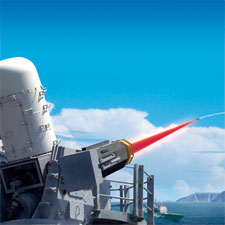In this amazing video, the U.S. Navy test their new “laser cannon” to shoot down an unmanned drone plane during a practice scenario. The laser is powerful enough to target a fast flying object and incinerate it.
I don’t know what to think honestly. I mean, it sounds like a good defense weapon that could be used to protect countries from long-range missiles, but in reality, it could be a devastating weapon used to oppress. Can you imagine the technology becoming so available and affordable that local police departments use it to fight crime? I don’t mean to say that you will see some criminal running down the street running away with some poor woman’s purse and all of a sudden is immolated by an orbiting police satellite. No.
But what if it was adapted to be less lethal. More like setting the laser to “stun mode”. In which it could be used to effectively subdue a person from miles above. Sure it may sound great in the efforts to defeat crime, but what if the technology fell into the wrong hands? Or what if the technology backfires and incinerates a whole city block?
Remember the “BigDog” video?
This reminds me of President Reagan’s SDI program. Nicknamed “Star wars”.
Guys, sh*t just got real.
Full source: Scientific American
7 commentsIn a grainy, black-and-white video that looks like a home movie of a UFO attack a sleek aircraft streaks through the sky one minute, only to burst into flames the next and plummet into the sea. The silent video, which Raytheon Co. debuts Monday at the U.K.’s Farnborough International Air Show 2010, however, is not science fiction. The defense contractor says it depicts part of a test conducted in May during which the U.S. Navy used a solid-state laser to shoot down unmanned aerial vehicles over the Pacific Ocean.
During the test, the Navy’s Laser Weapon System (LaWS), guided by Raytheon’s Phalanx Close-In Weapon System sensors, engaged and destroyed four UAV targets flying over water near the Navy’s weapons and training facility on San Nicolas Island in California’s Santa Barbara Channel, about 120 kilometers west of Los Angeles. The Phalanx—a rapid-fire, computer-controlled, radar-guided gun system—used electro-optical tracking and radio frequency sensors to provide range data to the LaWS, which is made up of six solid-state lasers with an output of 32 kilowatts that simultaneously focus on a target.
Read More: Scientific American





